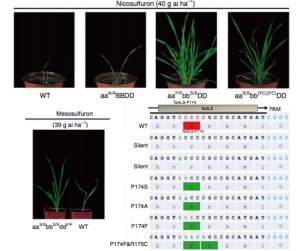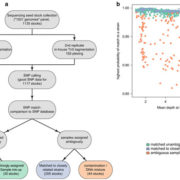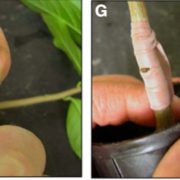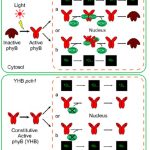Generation of herbicide tolerance traits and a new selectable marker in wheat using base editing (Nature Plants)
 Nowadays, weeds represents a major problem to agriculture due to the limited availability and expense of tools to manage them. Using new technologies to create herbicide-tolerant, non-transgenic varieties could improve weed control. Here, Li et al. analyzed multiallelic editing of the wheat TaALS (encoding acetolactate synthase) gene. ALS is a key enzyme in the synthesis of branched-chain amino acids and mutations at different sites confer resistance to various herbicides. TaALS-P174 is a proline-encoding CCC codon that is conserved among the wheat subgenomes. Multi-subgenome changes were made by targeting Cas9 fused to cytidine deaminase (for editing cytidine to thymine) to this codon. Missense edited mutants (for example, TCC or TTC) showed resistance to the herbicide nicosulfuron. Because co-editing can occur when two different sgRNAs are cloned into the same base-editing vector, the authors introduced a second guide RNA targeting a different TaALS codon, G631, leading to resistance to a second herbicide. The TaALS-P174-based co-editing selection system was also coupled with other targets, such as the acetyl-coenzyme A carboxylase gene, leading to nicosulfuron and quizafalop tolerance. In this way, the TaALS-P174 co-editing strategy enables selection of non-trasgenic gene edited plants with multiple herbicide tolearances. (Summary by Ana Valladares). Nature Plants. 10.1038/s41477-019-0405-0
Nowadays, weeds represents a major problem to agriculture due to the limited availability and expense of tools to manage them. Using new technologies to create herbicide-tolerant, non-transgenic varieties could improve weed control. Here, Li et al. analyzed multiallelic editing of the wheat TaALS (encoding acetolactate synthase) gene. ALS is a key enzyme in the synthesis of branched-chain amino acids and mutations at different sites confer resistance to various herbicides. TaALS-P174 is a proline-encoding CCC codon that is conserved among the wheat subgenomes. Multi-subgenome changes were made by targeting Cas9 fused to cytidine deaminase (for editing cytidine to thymine) to this codon. Missense edited mutants (for example, TCC or TTC) showed resistance to the herbicide nicosulfuron. Because co-editing can occur when two different sgRNAs are cloned into the same base-editing vector, the authors introduced a second guide RNA targeting a different TaALS codon, G631, leading to resistance to a second herbicide. The TaALS-P174-based co-editing selection system was also coupled with other targets, such as the acetyl-coenzyme A carboxylase gene, leading to nicosulfuron and quizafalop tolerance. In this way, the TaALS-P174 co-editing strategy enables selection of non-trasgenic gene edited plants with multiple herbicide tolearances. (Summary by Ana Valladares). Nature Plants. 10.1038/s41477-019-0405-0









